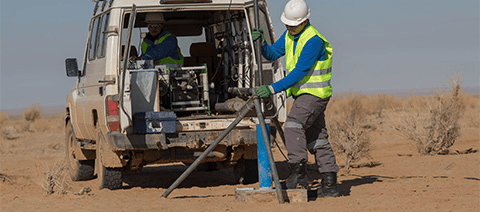isr technology
In Situ Recovery technology (ISR) is a proven method of extracting uranium from sandstone-type uranium deposits that cannot be mined using the conventional open cast or underground mining techniques.
ISR is now the method the most frequently used to mine uranium. It is also used to extract other metals, especially copper.

48% of uranium ores worldwide are mined using ISR technology

X3 share of ISR mining in the Uranium Mining production since 2000
Uranium In-Situ Recovery at Zuuvch Ovoo
UNDERSTANDING ISR
The In Situ Recovery (ISR) method can be used to mine low-grade uranium deposits when geological conditions are suitable.
A small portion of non-potable groundwater is extracted to which around 2% of sulfuric acid is added. The acidified water is equivalent to 1.5pH.
The acidified water is injected into wells to reach the aquifer hosting the uranium deposit only. The acidified water dissolves the uranium and moves it towards the production well. The solution carrying the uranium is then pumped towards the surface for processing. Uranium is then extracted from the solution to produce natural saleable uranium concentrate.
With ISR, the target metal is recovered from the deposit without excavating the host rock.
ADVANTAGES OF ISR
ISR has become a popular method because it has economical, technical and environmental advantages over conventional open cast or underground mining:
- Lower capital costs (no mining fleet, no ore crushing, simpler processing plant)
- Lower operating costs (no blasting, no earth-moving)
- Greater flexibility in production capacity
- No waste or ore removed
- No creation of open pits, waste dumps or tailings
- No mine dewatering
- Minimal visual disturbance
- Minimal noise, dust and diesel emissions (minimal use of heavy equipment, no haulage road)
CONDITIONS FOR THE ISR UTILIZATION
The ISR method can be used to extract low-grade uranium deposits when geological conditions are suitable.
- The geological formation containing the uranium, mainly sandstone layers, must be permeable enough to allow the leaching solution and recovery solution to circulate through the mineralization.
- The deep aquifer that contains the uranium ore-body is naturally rich in salt, metals and uranium, reflecting the fact that the groundwater is not potable.

GROUNDWATER PROTECTION PRINCIPLES
The major environmental issue associated with ISR is the protection of groundwater. The following groundwater protection principles apply:
- The local groundwater system is fully mapped prior to ISR mining
- ISR mining should not compromise a water resource usable for drinking purposes
- At no stage should ISR mining compromise groundwater use in the mineralized aquifer outside an agreed distance (not exceeding a few kilometers)
- ISR mining should not affect other aquifers present in the mining area
- Control wells are positioned within and around the extraction area to monitor groundwater flow and quality during operation
- After remediation, the post-mining groundwater quality should be returned to its pre-mining class of usage
Groundwater & Aquifers at Zuuvch Ovoo area




